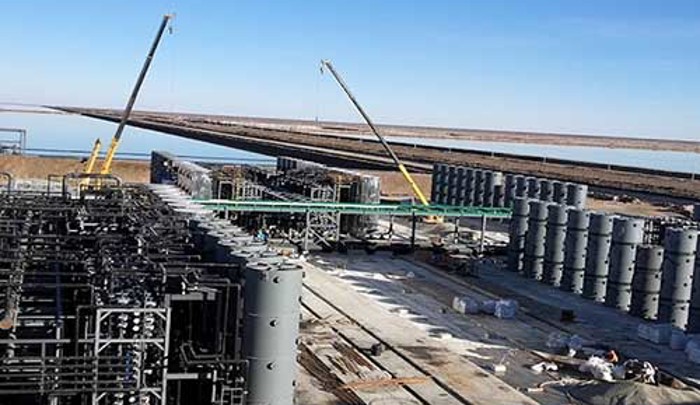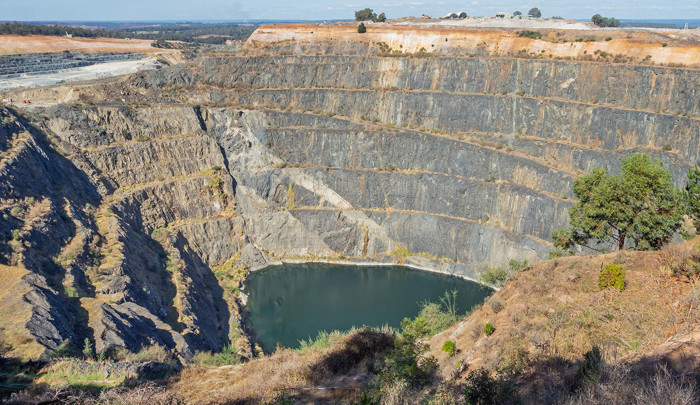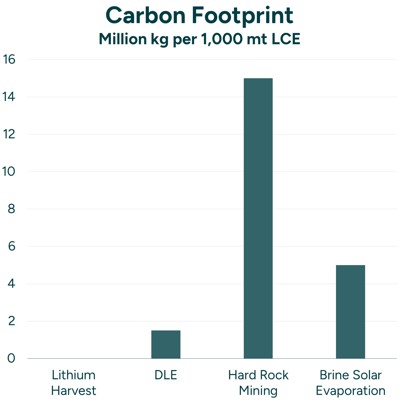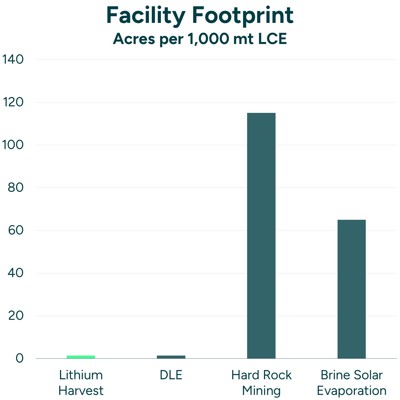Turning
Waste Into Sustainability
Advance your ESG goals and unlock new revenue by extracting lithium from produced water – a solution that aligns with global sustainability standards and accelerates the green energy transition.

Executive Summary
The demand for sustainable lithium is accelerating, and oil and gas companies are in a prime position to lead. At Lithium Harvest, we turn produced water - traditionally a costly waste stream - into one of the world’s most sustainable lithium sources.
Our patented solution supports circular economy goals, aligns with ESG commitments, and reduces environmental impact while unlocking new revenue streams. It’s not just about compliance. It’s about future-proofing your operations, strengthening stakeholder trust, and setting a new standard for responsible mineral extraction.
By partnering with Lithium Harvest, you’ll improve efficiency, attract sustainability-focused investors, and actively contribute to the green energy transition, turning environmental responsibility into a competitive advantage.
Table of contents:
Sustainability and Environmental Innovation
We turn produced water - a costly byproduct of oil and gas operations - into a valuable asset. Our advanced extraction solution transforms this waste stream into high-purity lithium and other critical minerals, fueling the energy transition without expanding your environmental footprint.
This isn’t just recycling - it’s real circular economy innovation. By extracting value from waste, we reduce resource consumption, eliminate unnecessary disposal, and maximize efficiency. It’s an innovative, sustainable way to meet today’s regulatory expectations while contributing to global climate goals.
-
Future-Proofing Against Regulatory Changes
Environmental regulations are tightening - and they’re not slowing down. Our sustainable lithium extraction solution helps you stay ahead of the curve, not scramble to catch up. Designed with flexibility and compliance in mind, our solution adapts to evolving standards, keeping your operations running smoothly and minimizing regulatory risk.
By future-proofing your water management and mineral recovery strategy, you protect your business, enhance your ESG standing, and build long-term resilience in a shifting energy landscape.
-
Enhanced Community and Investor Relations
Sustainability isn’t just good for the planet - it’s good for business. Integrating Lithium Harvest’s solution shows communities, investors, and stakeholders that you’re serious about responsible operations.
Our process helps reduce environmental impact, making it easier to build trust with local communities and secure support for future projects. At the same time, it boosts your ESG profile - a growing priority for institutional investors and funds seeking long-term, low-risk opportunities. It’s a smart move that positions your company as a leader in innovation and environmental stewardship.
The fight against climate change is one of the greatest global challenges of the 21st century. The acceleration of the green energy transition highlights the need for sustainable lithium extraction.
Sustainable, Efficient, and Low-Impact Lithium Extraction
We don’t just extract lithium - we set a new benchmark for doing it responsibly. Lithium Harvest’s solution redefines sustainable mineral recovery: it is low impact, fast to deploy, and built for today’s ESG priorities.
- Carbon-neutral operations: Our closed-loop process eliminates the need for long-distance transport and energy-heavy refining. Powered by solar and built on low-pressure, energy-efficient systems, we eliminate up to 15 million kg of CO₂ emissions per 1,000 metric tons of lithium carbonate. And while electricity use contributes to our footprint, it’s offset by massive carbon savings from oilfield wastewater disposal, keeping our operations carbon neutral.
- Compact, eco-conscious facility design: Our modular plants are designed for direct integration with existing water treatment facilities. No sprawling evaporation ponds. No long pipelines. Just a 99% smaller land footprint than traditional mining, minimizing ecosystem disruption and protecting biodiversity.
- Water conservation leadership: We use what’s already there - produced water. Our system recycles over 90% of water internally and uses up to 96% less water than traditional lithium mining. That’s up to 500 million gallons saved per 1,000 metric tons of lithium - water that can be treated and reused for reinjection, agriculture, or industrial use.
Bottom Line: With Lithium Harvest, you’re not just reducing emissions or saving water - you’re getting a fast, sustainable path to lithium production that fits into your existing operations and meets tomorrow’s ESG expectations.

Lithium Harvest Solution |

DLE from Brine |

Solar Evaporation Brine Extraction |

Hard Rock Mining |
|
|---|---|---|---|---|
| Feedstock | Produced water | Continental brine | Continental brine | Rock / spodumene |
| Project implementation time | 12-15 months | 5-7 years | 13-15 years | 8-10 years |
| Lithium carbonate production time | 2 hours | 2 hours | 2-3 years | 3-6 months |
| Lithium yield | >95% | 80-95% | 20-40% | 6-7% |
| Average footprint per 1,000 mt LCE | 1.4 acres | 1.4 acres | 65 acres | 115 acres |
| System design | Modular and mobile | Mobile / stationary | Stationary | Stationary |
| Environmental impact | Minimal | Minimal | Soil- and water contamination | Soil- and water contamination |
| Water consumption per 1,000 mt LCE | 20 million gallons | 80 million gallons | 550 million gallons | 250 million gallons |
| CO₂ footprint per 1,000 mt LCE | Neutral | 1.5 million kg | 5 million kg | 15 million kg |
| Average invested capital per 1,000 mt LCE | $18 million | $45 million | $50 million | $60 million |
| Average cost per metric ton | $4,550 | $5,700 | $5,800 | $6,900 |

Lithium Harvest Solution

DLE from Brine

Solar Evaporation Brine Extraction

Hard Rock Mining
Where Green Technology Drives Business Forward
Achieving Carbon Neutrality
Our solution eliminates the need to transport materials to distant refining sites, significantly reducing emissions and environmental impact. With a low-pressure, energy-efficient process powered primarily by solar energy, we minimize operational emissions. While electricity use does create a carbon footprint, it's offset by avoided emissions from oilfield wastewater disposal. The result: effectively carbon-neutral operations that prevent up to 15 million kg of CO₂ emissions for every 1,000 metric tons of lithium carbonate produced compared to traditional mining.
Compact Facility Design - Eco-Conscious Operations
Sustainability starts with design. Our modular facilities are co-located with produced water treatment centers, enabling quick integration and deployment. Unlike conventional lithium extraction, our system doesn't rely on evaporation ponds or long pipelines - preserving land, reducing environmental disruption, and protecting local ecosystems.
Minimal Water Consumption - Protecting Vital Resources
Our closed-loop process uses produced water as a feedstock and recycles over 90% of the water. We don't draw on freshwater supplies; post-extraction, we can clean the water for reuse, from reinjection to industrial or agricultural use. Compared to traditional methods, we save up to 96% of water per ton of lithium, preserving over 500 million gallons for every 1,000 metric tons of lithium carbonate produced.
Turning Big Numbers into Real Impact
What do our sustainability savings really mean?
We get it - millions of kilograms of CO₂ and hundreds of millions of gallons of water can feel abstract. So let’s break it down into real-world terms that show just how powerful our impact is:
-
CO₂ Savings
For every 1,000 metric tons of lithium carbonate produced, we save up to 15 million kilograms of CO₂ emissions. That’s like taking 3,261 cars off the road for a whole year - the equivalent of parking an entire small town’s worth of vehicles. That’s the kind of impact we’re making.
-
Water Savings
We save up to 500 million gallons of water for every 1,000 metric tons of lithium carbonate produced. That’s enough to fill 758 Olympic-sized swimming pools - or, if you prefer coffee over laps, about 7.89 billion cups. Now that’s a serious thirst quencher.
-
Battery Lifecycle Emissions
With Lithium Harvest, an EV using our lithium reaches greenhouse gas (GHG) break-even after just 3,500 miles (or 6,000 kilometers) - about the distance from New York to Los Angeles and halfway up to San Francisco. Traditional lithium? It takes nearly 11,000 miles (or 18,000 kilometers), over three times as far. That’s a massive cut in emissions and mileage before you even start saving the planet.
-
Water and Land Use for Each EV
Each electric vehicle made with our lithium saves 15 to 20 cubic meters of water - enough to fill a backyard swimming pool. And the land savings? We free up space equal to a large apartment for every EV produced. That’s less waste, less sprawl, and more room for the planet to breathe.
-
Land Use Efficiency
Our extraction process uses 99% less land than hard rock mining. A typical lithium mine might sprawl across 115 acres - about 87 football fields. We need just 1.4 acres - roughly the space of two tennis courts. That’s lithium production without the land grab.
How We Make EVs Even Greener
The electric vehicle (EV) industry is accelerating fast, and at Lithium Harvest, we're helping it get even cleaner. While EVs are already a win for the environment, the true impact lies in how their batteries are made. That's where we step in - transforming the lithium supply chain from the ground up.
Revolutionizing Lithium Extraction
Our patented solution extracts lithium from oilfield wastewater, a method that slashes up to 47% of battery lifecycle emissions. This dramatically reduces an EV's breakeven point from 18,000 km to just 6,000 km, a game-changing leap in making clean transportation truly sustainable.
Environmental Impact - Per EV
- Water savings: 15–20 cubic meters saved per EV - enough to fill a backyard pool.
- Land savings: 50–100 square meters preserved - the size of a spacious apartment.
Setting a New Standard in Lithium Sustainability
Our solution doesn't just reduce CO₂ emissions - it redefines sustainable lithium production. With lower energy demands, minimal land disruption, and over 90% water recycling, we're setting a new benchmark for environmental responsibility in EV battery supply chains.
This is how we help the EV revolution drive further - without driving up emissions.

We turn wastewater into high-value minerals
-
Unlocking the value of waste: Transforming produced water into a valuable resource through resource recovery and a circular economy approach.
-
Energy-efficient and low-carbon footprint: Minimizing environmental impact through advanced technologies and optimized operational efficiency.
-
Responsible water management: Conserving water resources and minimizing freshwater consumption to support sustainable water practices.
-
Facilitating the clean energy transition: Enabling the production of sustainable lithium for electric vehicles and renewable energy storage, contributing to climate change mitigation.
Unlock the potential of sustainable lithium extraction today!
Download Brochure PDF, 788.73 KBNeed to Introduce Someone?
Want to spark interest, build alignment, or make the case for sustainable lithium extraction? Whether you’re educating stakeholders, briefing team members, or exploring new growth opportunities, our whitepapers are built to help.
Arm your team with clear insights on how produced water can become a profit driver - and how your business can lead the green energy transition with Lithium Harvest.
Get the whitepaper. Start the conversation.
Contact Us
Our team of experts is ready to help you.



